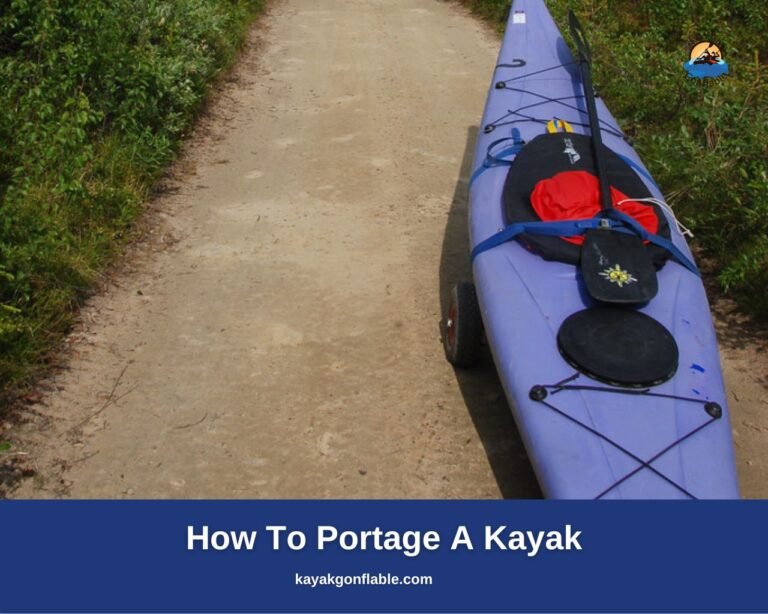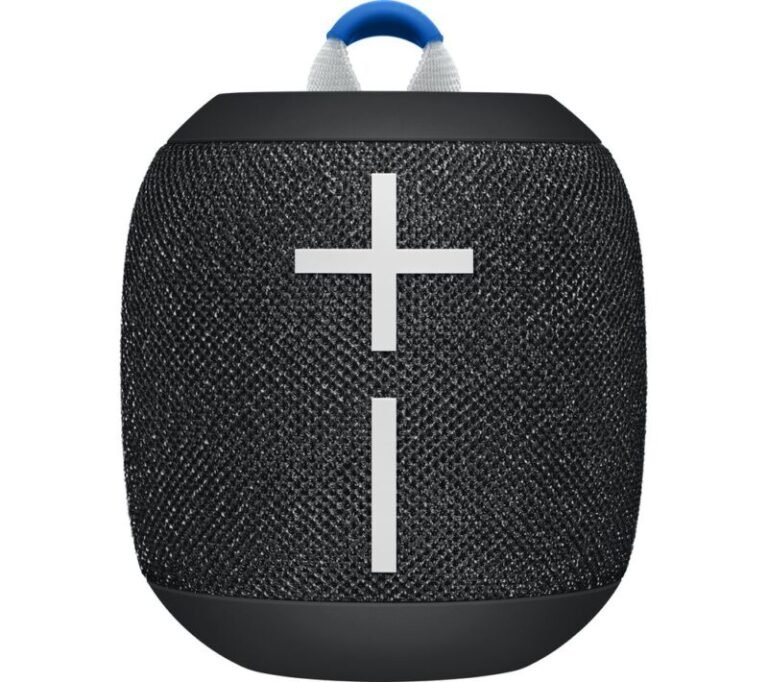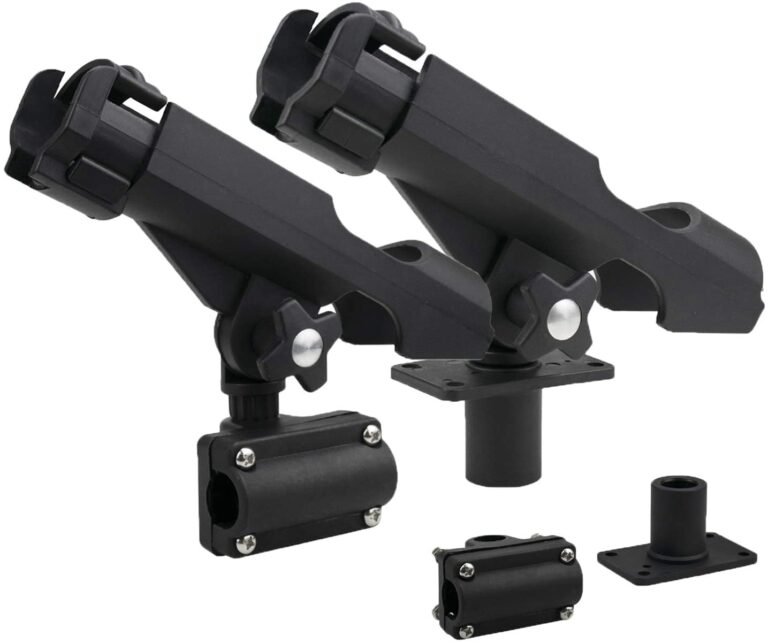Cómo hacer kayak: una guía detallada para principiantes
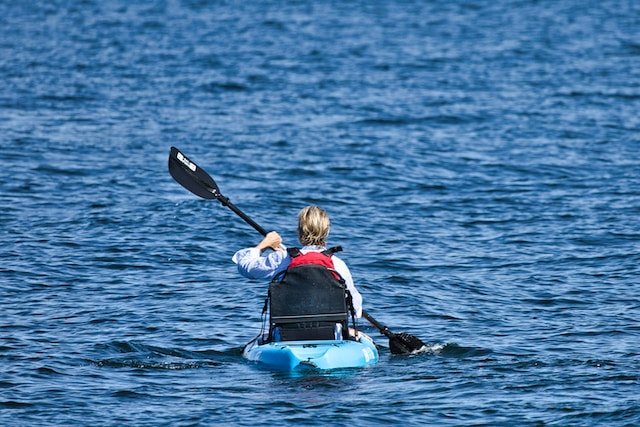
El kayak es un famoso deporte de remo cuya popularidad crece cada día. El deporte es una excelente manera de hacer ejercicio mientras se divierte o incluso busca la euforia y la emoción del peligro.
El kayak se adapta a remeros de todas las edades y niveles de condición física. Naturalmente, a medida que el deporte se vuelve más conocido, cada vez más personas se sienten atraídas por sus encantos y comienzan a preguntarse qué implica exactamente el kayak y si pueden practicarlo.
El comienzo de todo es muy importante y, como tal, este artículo proporciona a los principiantes el conocimiento que necesitan para que su aventura en kayak sea divertida. ¡Sigue leyendo y diviértete!
¿Qué es el kayak?
El kayak es un deporte acuático en el que el jugador se sienta en una pequeña embarcación conocida como kayak y utiliza un remo de doble hoja para moverse por el agua. Se cree que el kayak se originó en la región ártica, donde era utilizado por los inuit para el transporte y la caza.
Hoy en día, personas de todas las edades y habilidades en todo el mundo disfrutan del kayak. Es una excelente manera de disfrutar del aire libre, hacer algo de ejercicio e incluso aprender algunas habilidades nuevas.
El kayak se considera una actividad tanto recreativa como competitiva, y existen muchas diferentes tipos de kayaks Disponibles para adaptarse a diferentes estilos de remar.
Los kayaks están diseñados para remar solo o en tándem y pueden usarse en una variedad de entornos, incluidos ríos, lagos y el océano. Los kayaks se pueden utilizar para hacer turismo, kayak de aguas bravas, pescar e incluso acampar.
Beneficios del kayak
Si aún no estás convencido de que el kayak es para ti y estás leyendo esto por curiosidad o por alguien, conocer algunos de los beneficios de este gran deporte puede ser de gran ayuda para cambiar de opinión y darte cuenta de que el kayak está en hecho para todos. Los beneficios del kayak se detallan a continuación.
- El kayak es una actividad de bajo impacto que no daña las articulaciones.
- Es una excelente manera de hacer algo de ejercicio sin sentir que estás haciendo ejercicio.
- Hacer kayak puede ser una excelente manera de relajarse y desestresarse.
- Hacer kayak es una excelente manera de conectarse con la naturaleza.
- Puede ser una excelente manera de vincularse con amigos o familiares.
- Hacer kayak es una excelente manera de tomar aire fresco y vitamina D.
- Es una excelente manera de mejorar su equilibrio y coordinación.
Lo que necesitarás para empezar a practicar kayak
Ahora que ya tienes una idea de lo que implica el kayak y conoces los beneficios de este deporte de remo, veamos el equipo que necesitarás para empezar a practicar kayak.
Dado que recién está desarrollando un interés en el deporte o recién comienza a actuar según su interés, alquilar o pedir prestado el equipo que necesitará es un curso de acción inteligente.
La razón es que te permite probar todo el equipo de kayak disponible para que puedas tomar la mejor decisión al comprar el tuyo propio o, en el peor de los casos, no perderás mucho si decides abandonar el kayak en un futuro cercano. .
El equipo necesario para comenzar su aventura en kayak se detalla a continuación.

un kayak
Naturalmente, no puedes navegar en kayak sin un kayak, por lo que no debería sorprender que sea el primer equipo y quizás el más importante que debes adquirir. Los kayaks son pequeñas embarcaciones que se reman con remos de doble hoja.
Existen varios tipos de kayaks, como kayaks de recreo, kayaks de mar, kayaks de travesía, kayaks de pesca, kayaks de aguas bravas y kayaks inflables, pero como principiante, se recomienda optar por un kayak recreativo.
El kayak que elijas depende en última instancia de las condiciones en las que pretendas navegar. Los kayaks pueden ser individuales (para un solo remero) o en tándem (diseñados para dos remeros).
Los kayaks se dividen en términos generales en dos categorías según el estilo de su cabina. Son kayaks sit-in y kayaks sit-on-top.
Kayaks sentados
Los kayaks sentados son un tipo de kayak popular entre los remeros y son ideales tanto para principiantes como para kayakistas experimentados. Estos kayaks reciben ese nombre debido a su diseño de cabina cerrada.
Esto implica que tengan una zona para sentarse bien definida y que el palista pueda sentarse cómodamente mientras rema en su embarcación.
Ventajas
Las ventajas de los kayaks sentados incluyen:
- El diseño de cabina cerrada proporciona una mejor protección contra los elementos, lo que hace que estos kayaks sean ideales para cualquier entorno, especialmente cuando hace frío y se evita el agua.
- Cuando se combina bien con un faldón contra salpicaduras, un kayak sentado puede mantener el agua fuera de la embarcación incluso en caso de volcar, por lo que es ideal para aquellos que desean el menor contacto posible con el agua.
- Los kayaks con asiento ofrecen una experiencia más cómoda, ya que no es necesario ajustar constantemente la posición para mantener el equilibrio.
- Son más estables y maniobrables que los kayaks con asiento.
- Tienen más espacio de almacenamiento que sus homólogos de asiento.
Contras
Algunas desventajas de los kayaks sentados incluyen:
- Los kayaks sentados suelen ser más caros que sus homólogos sentados.
- Su diseño de cabina cerrada hace que sea más difícil entrar y salir de ellos, especialmente si no estás acostumbrado a ellos.
- La restricción de la cabina cerrada puede resultar incómoda si se rema durante largos períodos de tiempo.
- Generalmente es más difícil volver a subirse a los kayaks con asiento si se vuelca.
Kayaks sentados encima
A diferencia del tipo de kayak anterior, estos kayaks tienen un diseño de cabina abierta. Los kayaks sentados en la parte superior son un tipo de kayak diseñado para que el palista se siente encima, en lugar de dentro.
Son populares para muchos tipos diferentes de kayak, incluidos recreación, pesca y surf. Los kayaks sit-on-top son fáciles de subir y bajar y ofrecen una gran libertad y flexibilidad al palista.
Ventajas
A continuación se detallan algunas ventajas de los kayaks con asiento.
- Son fáciles de entrar y salir gracias a su diseño de cabina abierta.
- Los kayaks sentados son más baratos que sus homólogos sentados.
- Son ideales para climas cálidos, ya que no estás encerrado en una cabina.
- Los kayaks sit-on-top son autovaciables ya que poseen orificios para imbornales que ayudan a drenar el agua que ingresa al kayak, evitando así que se inunde. Esos agujeros también son útiles cuando bloquear el kayak.
- Son más fáciles de volver a abordar en caso de que el barco vuelque.
Contras
A continuación se detallan algunas desventajas de los kayaks con asiento encima.
- Su diseño de cabina abierta expone al palista a la ira de los elementos, lo que los hace poco ideales para condiciones climáticas frías.
- Son menos estables que sus homólogos sentados, especialmente en condiciones de viento o aguas turbulentas.
- Los kayaks con asiento encima son más difíciles de maniobrar, especialmente en curvas cerradas.
- Su centro de gravedad más alto los hace menos eficientes para remar que sus homólogos sentados.
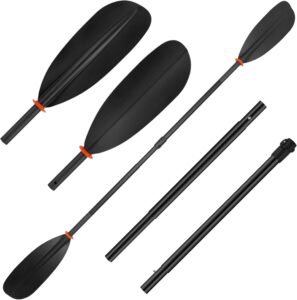
un remo
Por supuesto, una vez que tengas un kayak adecuado, necesitarás un remo. Usar un remo adecuado a su altura, ancho del kayak y estilo de remo puede marcar una gran diferencia en su experiencia de navegación en kayak, así que asegúrese de elegir el correcto.
Tenga en cuenta los materiales con los que está hecha la pala, la forma de la pala, la marca y cualquier otra información importante a la hora de elegir su pala. Encontrarás una guía de tallas de remo muy útil en esta etapa.

Chaleco salvavidas
Un chaleco salvavidas es un equipo imprescindible para cualquiera que se inicie en el kayak. Es un dispositivo de flotación personal que ayuda a mantener a flote al usuario en el agua y puede ser invaluable en una emergencia de kayak.
Usar un chaleco salvavidas mientras navegas en kayak puede ayudar a prevenir ahogamientos y otras lesiones graves. Vida chaquetas También puede ayudarle a protegerse de los elementos. Por lo tanto, es fundamental que elija un buen chaleco salvavidas que le quede bien y que sea cómodo de llevar.
Además, asegúrese de que su chaleco salvavidas sea apropiado para las condiciones del agua en las que navegará en kayak y aprenda a usarlo correctamente.
Equipo y ropa para kayak
Si bien el kayak, el remo y el chaleco salvavidas son los equipos más importantes que un kayakista necesita para un viaje seguro, no son el único equipo a su disposición.
Si quieres vivir una aventura agradable y cómoda, tendrás que llevar ropa adecuada y conseguir al menos parte del equipo que se indica a continuación.
- Falda de pulverización: Para ayudar a mantener el agua fuera de la cabina de su kayak y mantenerse seco.
- bomba de achique: Para deshacerse del agua que pueda entrar en su kayak.
- Aperitivos: Proporcionar energía remando es un trabajo serio. Llevar un almuerzo más elaborado y tomarte un descanso también es fundamental si planeas remar durante largas horas.
- Agua potable: Para mantenerte hidratado en el agua.
- Proteccion solar: Esto implica el uso de protector solar, gafas de sol, protector labial, gafas de sol y cualquier otro medio que puedas utilizar para protegerte de los rayos ultravioleta del sol.
- Bolsas secas: Para ayudar a mantener seco lo que no quieras que se moje.
- Luces para kayak: Para kayak de noche o en condiciones de baja visibilidad.
- Mirar: Para ayudarle a cronometrar y planificar su viaje.
- Silbar: Para pedir ayuda en caso de emergencia. Tener una bengala a mano también podría resultar útil por motivos similares.
En cuanto a la ropa, se recomienda llevar prendas que se sequen fácilmente, especialmente cuando se practica kayak en un clima frío. Esto significa que no debe haber ningún material hecho de algodón u otro material de secado lento en su arsenal de ropa para kayak.
Tu ropa también depende del clima. En verano o clima caliente, puedes conformarte con ropa ligera, pero cuando navegues en kayak en un clima frío, debes asegurarte de que tu ropa conserve el calor.
Puedes preguntarle a tu instructor de kayak más sobre la ropa adecuada para cada clima o condición del agua.
Cómo empezar a practicar kayak
Una vez que haya pedido prestado, alquilado o comprado todo lo que necesita para navegar en kayak, le recomiendo contratar un instructor de kayak.
Si bien es cierto que puedes aprender este deporte online o por tu cuenta, contar con un kayakista experimentado que te dé algunos consejos te ahorrará muchos problemas y facilitará tu proceso de aprendizaje.
Si prefieres hacer las cosas en grupo, puedes unirte a un club de kayak local y participar en sus ejercicios.
Empiece de forma sencilla. Practica entrar y salir de tu kayak con tu instructor. Él o ella le dará sugerencias para facilitar la tarea, le informará sobre cualquier error que cometa y le informará sobre los errores comunes de los principiantes que debe evitar.
Su punto de partida podría ser una piscina bastante grande o cualquier masa de agua plana a su alrededor.
A continuación, debes trabajar para meter y sacar tu kayak del agua de forma segura. Si bien esto puede parecer poco importante, no se debe subestimar su valor.
Si desea que su kayak resista el paso del tiempo, debe manipularlo con cuidado, y parte de ese cuidado es colocarlo correctamente en el agua. También se debe practicar la botadura del kayak, e incluso se debe discutir cómo finalizar la sesión de remo.
Su instructor también debería informarle sobre el transporte, mantenimiento y almacenamiento de kayaks. Conocer lo que se debe y no se debe hacer con su embarcación lo antes posible le permitirá cuidarla mejor, así que tome en serio las palabras de su instructor.
El próximo hito debería ser practicar brazadas de kayak. Las brazadas de kayak son técnicas de remo que te ayudarán a controlar tu kayak en el agua y son herramientas indispensables si quieres convertirte en un maestro del kayak.
La primera de estas brazadas es la brazada hacia adelante, que se centra en el impulso hacia adelante y la propulsión del kayak. Algunos de los otros incluyen el trazo inverso y el trazo de barrido.
Hablaremos más sobre las brazadas de kayak más adelante en este artículo. Sin embargo, debes tener en cuenta que, dado que estos estilos son esenciales para navegar en kayak, es posible que no sean tan fáciles de aprender como parecen, así que no te frustres si no los aprendes de inmediato.
Con un poco de perseverancia y trabajo duro, deberías poder dominarlos en poco tiempo.
Una vez que hayas dominado la brazada hacia adelante, podrás realizar una pequeña sesión de remo semisupervisada. El objetivo de esto es determinar cuánto de lo que ha aprendido ha asimilado y qué tan bien puede hacerlo por su cuenta.
Recuerde que navegar en kayak debe ser divertido, por lo que no debe avergonzarse de moverse a su propio ritmo. Estas pruebas supervisadas con tu instructor también te ayudarán a desarrollar tus piernas acuáticas y a desarrollar confianza en ti mismo.
Continúe practicando las brazadas de kayak mientras se familiariza con otras técnicas de kayak que existen, como salida mojada, rodando tu kayak, enderezar un kayak volcado, transportar su kayak, etc.
La lista continúa y es un viaje que vale la pena para cualquiera que pretenda convertirse en un ávido kayakista. No será fácil, pero recuerda, el viaje de mil millas comienza con un paso.
Las brazadas básicas del kayak
Como la mayoría de los deportes, el kayak tiene técnicas que, una vez dominadas, hacen que el deporte sea más seguro y divertido, y la principal de ellas son las brazadas de kayak. Estos golpes son técnicas de remo que le ayudarán a controlar su embarcación y, sin ellos, podría estar en peligro.
Los cuatro movimientos básicos del kayak son el movimiento hacia adelante, el movimiento hacia atrás, el movimiento de barrido y el movimiento de tracción. Se explican a continuación.
El golpe hacia adelante
En kayak, la brazada hacia adelante es la brazada más común y básica que se utiliza para impulsar el kayak hacia adelante en el agua.
Se realiza utilizando un remo de doble pala y se ejecuta clavando una pala del remo en el agua y luego usando esa misma pala para tirar del kayak hacia adelante.
La otra pala del remo se utiliza luego para proporcionar resistencia contra el agua, actuando como una especie de freno. En pocas palabras, la brazada hacia adelante implica remar a ambos lados del kayak para avanzar.
Sin embargo, debes asegurarte de mantener los golpes uniformes en ambos lados. La brazada de avance se utiliza para mover el kayak hacia adelante en línea recta y es la base para técnicas de navegación en kayak más avanzadas, por lo que debe dominarse.
El trazo inverso
Si bien el golpe hacia adelante es el más importante de los golpes, su opuesto, el golpe hacia atrás, también es bastante útil. Los brazadas inversas son una parte importante del kayak y, a menudo, se utilizan para corregir el rumbo.
Se realizan remando hacia atrás y se pueden utilizar para detener o frenar el kayak. También se pueden utilizar brazadas inversas para girar el kayak en espacios reducidos.
Si es necesario, también se puede utilizar una brazada inversa para mover el kayak hacia atrás, una habilidad útil si se evita el destino.
El golpe de barrido
En kayak, la brazada de barrido se utiliza para realizar giros. Se ejecuta remando en un lado del kayak y usando el otro remo para barrer el agua en un amplio arco. La brazada se puede utilizar para girar el kayak en cualquier dirección.
La brazada de barrido es una parte importante del kayak y se utiliza con frecuencia al remar. Es un trazo sencillo que se puede ejecutar de forma rápida y sencilla.
Una brazada de barrido realizada en el lado derecho del kayak girará la embarcación hacia la izquierda, mientras que una brazada de barrido realizada en el lado izquierdo del kayak girará la embarcación hacia la derecha.
El trazo de empate
Al remar en un kayak, la brazada de tracción se utiliza para mover la embarcación lateralmente o hacia los lados. También se puede utilizar para girar el kayak en un círculo cerrado.
Para ejecutar un golpe de tracción, extienda la pala con la pala perpendicular al kayak y tire de la pala a través del agua hacia la popa del kayak. El otro brazo se utiliza para estabilizar el kayak.
La brazada se puede utilizar en cualquier lado del kayak y, a menudo, se utiliza junto con otras brazadas para maniobrar el kayak alrededor de obstáculos en el agua, como rocas o troncos.
Consejos de seguridad para kayakistas
Hacer kayak es una excelente manera de disfrutar del aire libre y hacer algo de ejercicio, pero es importante estar seguro mientras lo hace. Aquí hay algunos consejos de seguridad para kayakistas:
- Utilice siempre un chaleco salvavidas. Le ayudará a mantenerse a flote en caso de que ocurra algo peligroso en el agua.
- No se aísle: dígale a alguien adónde va y cuándo regresará. Esto garantizará que pueda llegarle ayuda incluso si no puede enviar una alerta de emergencia cuando las cosas empiecen a ir mal.
- Esté atento a las condiciones climáticas: los fuertes vientos y olas pueden provocar kayak difícil y peligroso.
- Esté atento a su entorno y esté atento a los obstáculos en el agua. Quieres evitar colisiones.
- Nunca bebas y hagas kayak. Los efectos del alcohol en el agua son peores que sus efectos en tierra, por lo que beber antes o mientras se practica kayak siempre es una mala idea.
- Siga todas las regulaciones locales. Existen reglas para la seguridad de todos aquellos que están en el agua, por lo que cumplirlas es crucial para la seguridad de vidas y propiedades. Obedecer todas las normas locales y reglas de navegación en todo momento.
- Consulta siempre la previsión meteorológica antes de salir. Eso le dará una idea de qué esperar en el agua.
Kayak avanzado
A medida que adquiera experiencia en kayak, es posible que desee explorar técnicas y tipos de kayak más avanzados. Aquí hay algunas habilidades avanzadas a considerar:
La técnica del rollo esquimal
El rollo esquimal es un técnica avanzada de kayak que le permite recuperarse de una posición volcada sin salir del kayak. Es una habilidad valiosa para los remeros avanzados en aguas turbulentas. Para aprender a hacer esta tirada, considere recibir lecciones de un instructor calificado.
Kayak en aguas bravas
El kayak en aguas bravas es un deporte acuático emocionante pero desafiante que implica navegar por ríos rápidos, rápidos y obstáculos.
Kayak de surf
El kayak de surf implica remar mar adentro y montar las olas del océano en un kayak. Requiere control avanzado del remo y habilidades para leer las olas. Asegúrese de practicar en olas más pequeñas antes de intentar olas más grandes y use siempre un casco por seguridad.
síun kayak
El kayak de mar implica viajes prolongados en aguas abiertas, como remar en la costa o en el océano.
Adecuadamente Mantenimiento y cuidado de su kayak
El mantenimiento y cuidado adecuados de su kayak y equipo son importantes para garantizar su longevidad, seguridad y rendimiento óptimo. Aquí hay un guía para ayudarte a mantener tu kayak equipo en plena forma:
Limpieza y almacenamiento de su kayak
Eliminación de agua salada y escombros
Después de cada viaje en kayak, enjuague bien su kayak con agua dulce para eliminar el agua salada y los restos o arena.
Preste especial atención a la cabina, las tapas de las escotillas y cualquier pieza metálica expuesta para evitar la corrosión. Además, utilice un cepillo suave o una esponja para frotar suavemente cualquier residuo o suciedad rebelde.
Almacenamiento adecuado
Almacenar tu kayak en un área fresca y seca, lejos de la luz solar directa y de fluctuaciones extremas de temperatura. Lo ideal es guardarlo en el interior o bajo un cubierta de kayak para protegerlo de los rayos UV, que pueden provocar la decoloración y deterioro de los materiales del kayak.
Mantenga su kayak alejado del suelo utilizando soportes o rejillas acolchados para evitar deformaciones y daños. Guarde el kayak boca abajo o de lado para evitar que se deforme la forma del casco.
A medida que el deporte de remo conocido como kayak se vuelve más popular, no sorprende que muchos quieran probarlo. El kayak es una excelente manera de hacer ejercicio y disfrutar de la naturaleza y puede ser una experiencia muy gratificante si se hace correctamente.
Como principiante, tienes un largo camino por recorrer antes de convertirte en un kayakista experimentado, por lo que para acelerar tu viaje, debes encontrar un amigo experimentado o un instructor de kayak que te ayude.
El primer paso es adquirir todo el equipo necesario para un viaje seguro y placentero, luego subirte a tu kayak y comenzar a remar bajo supervisión.
Asegúrese de seguir las instrucciones y realizar las correcciones. La práctica es lo siguiente que tienes que hacer. Debes practicar todo lo que aprendas y pronto serás un maestro.
Recuerde obedecer todas las reglas de seguridad para navegar en kayak y cumplir con las reglas del cuerpo de agua en el que navega. Finalmente, ¡diviértase y diviértase en el agua!

